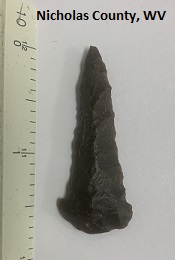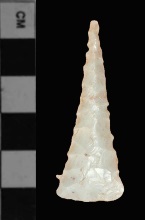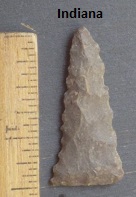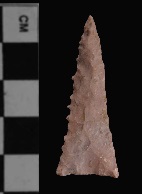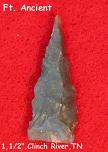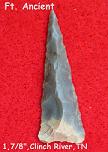Outline is Representative of Size and Shape:

Name Details:
Identified By: Collectors, formalized by Robert E. Bell
Named For: Associated Culture
Date Identified: 1958
Type Site: Most commonly associated with the Feurt Mounds and Village Scioto County, Ohio
Identified By: Collectors, formalized by Robert E. Bell
Named For: Associated Culture
Date Identified: 1958
Type Site: Most commonly associated with the Feurt Mounds and Village Scioto County, Ohio
Point Validity:
Valid type
This type has been discussed in numerous professional publications and is widely recognized by professionals as a valid type.
This type has been discussed in numerous professional publications and is widely recognized by professionals as a valid type.
Fort Ancient Triangle
Cluster: Late Woodland to Early Mississippian Triangle Cluster Description of Physical Characteristics and Flaking Pattern:
This is a small to medium (1.25 to 2 inches) serrated triangular point. This point has an elliptical cross section and is usually thick. The blade is primarily straight, but in rare examples the blade may be slightly incurvate but rarely slightly excurvate. The blade is long and narrow and commonly has deep serrations, but non-serrated examples do occur. The base may vary from straight to convex and may have basal thinning. This point generally has a high degree of workmanship and a random flaking pattern.
Size Measurements:
Total Length -30 to 50 mm, Width - 15 mm or less, Thickness - 4 to 7 mm (Bell, 1960)
Total Length -30 to 50 mm, Width - 15 mm or less, Thickness - 4 to 7 mm (Bell, 1960)
Commonly Utilized Material:
Additional Comments:
Trade goods with colonist have been found in sites with these points suggesting that this culture and use of these points may have remained into the times of settlement (Bell, 1960)
One key feature that distinguishes the Fort Ancient point from other related triangular points are the deep serrations. One exception is the Sand Mountain point which also has deep serrations.
Trade goods with colonist have been found in sites with these points suggesting that this culture and use of these points may have remained into the times of settlement (Bell, 1960)
One key feature that distinguishes the Fort Ancient point from other related triangular points are the deep serrations. One exception is the Sand Mountain point which also has deep serrations.
Distribution: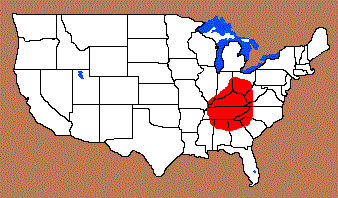
Distribution Comments:
This point is most common and commonly associated with the Ohio River Valley and the Tennessee River Valley and the headwaters of both rivers.
This point is most common and commonly associated with the Ohio River Valley and the Tennessee River Valley and the headwaters of both rivers.
Age / Periods:
Date: 800 - 400 B.P.
Cultural Period: Mississippian
Glacial Period: Medieval Warm to Little Ice Age
Culture: Fort Ancient Culture
Date: 800 - 400 B.P.
Cultural Period: Mississippian
Glacial Period: Medieval Warm to Little Ice Age
Culture: Fort Ancient Culture
Age Details:
This point is associated with the Fort Ancient Focus of the Ohio Valley (Bell, 1958)
This point is associated with the Fort Ancient Focus of the Ohio Valley (Bell, 1958)
Other points in this cluster / Related / Associated Points:
Fort Ancient Blade, Hamilton Triangle, Madison, Maud, Levanna, Uwharrie, Yadkin
Fort Ancient Blade, Hamilton Triangle, Madison, Maud, Levanna, Uwharrie, Yadkin

